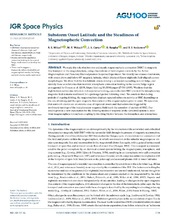Substorm Onset Latitude and the Steadiness of Magnetospheric Convection
Peer reviewed, Journal article
Published version

Åpne
Permanent lenke
https://hdl.handle.net/1956/22486Utgivelsesdato
2019-03-10Metadata
Vis full innførselSamlinger
Originalversjon
https://doi.org/10.1029/2018ja025969Sammendrag
We study the role of substorms and steady magnetospheric convection (SMC) in magnetic flux transport in the magnetosphere, using observations of field‐aligned currents by the Active Magnetosphere and Planetary Electrodynamics Response Experiment. We identify two classes of substorm, with onsets above and below 65° magnetic latitude, which display different nightside field‐aligned current morphologies. We show that the low‐latitude onsets develop a poleward‐expanding auroral bulge, and identify these as substorms that manifest ionospheric convection‐braking in the auroral bulge region as suggested by Grocott et al. (2009, https://doi.org/10.5194/angeo-27-591-2009). We show that the high‐latitude substorms, which do not experience braking, can evolve into SMC events if the interplanetary magnetic field remains southward for a prolonged period following onset. We conclude that during periods of ongoing driving, the magnetosphere displays repeated substorm activity or SMC depending on the rate of driving and the open magnetic flux content of the magnetosphere prior to onset. We speculate that sawtooth events are an extreme case of repeated onsets and that substorms triggered by northward‐turnings of the interplanetary magnetic field mark the cessation of periods of SMC. Our results provide a new explanation for the differing modes of response of the terrestrial system to solar wind‐magnetosphere‐ionosphere coupling by invoking friction between the ionosphere and atmosphere.
